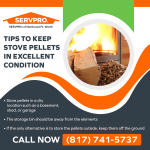Since home heating appliances are a common cause of home structure fires and fire damage in the United States, homeowners who rely upon a pellet stove for home heating should observe the proper precautions to protect against fire damage. Home heating equipment accounts for approximately 50,000 home structure fires and nearly $1 billion in property damage each year. After a fire, water damage restoration services may be needed as well. However, if the homeowner abides by fire safety practices when operating the pellet stove, the fire risk can be reduced.

1. Use top-quality pellets
A reliable source of high-quality pellets can be challenging to find for the pellet stove owner. A lack of regulation and standardization in quality control leaves the consumer at the mercy of the pellet manufacturer. Investigation into the various options can prove fruitless and, at times, frustrating.
One solution often recommended is to use pellets from a secondary pellet manufacturer. A secondary pellet manufacturer produces pellets as a byproduct of the primary business. An example would be lumber, furniture, or flooring business. The benefit of using pellets from these businesses is that the sawdust typically comes from better-quality wood that has been kiln-dried. Primary pellet manufacturers will use sawdust from a variety of wood sources, but the pellets will be inconsistent in quality.
All pellets need attention to preserve their quality. These quality control tips will keep stove pellets in excellent condition and ready for use.
- Store pellets in a dry location such as a basement, shed, or garage.
- The storage bin should be away from the elements.
- If the only alternative is to store the pellets outside, keep them off the ground. Put a moisture barrier (a piece of plastic) between the pellets and the ground. Cover the pellets with a heavy-duty tarp or thick mil plastic to protect against rain, snow, and ice.
Pellets that are low quality or laden with moisture are difficult to ignite, and slow ignition can cause the burn pot to become overloaded. The excessive amount of slowly burning pellets can suddenly ignite, causing a small explosion inside the stove. Great care should be taken when it appears that such a scenario might develop when lighting the pellets.
2. Practice regular stove maintenance to keep the stove clean and safe
Homeowners need to be aware of the importance of keeping the pellet stove clean. Poor maintenance is a leading cause of pellet stove fires. Fly ash, a very fine ash residue, can collect in the flue and ash traps. At high temperatures, ash will melt. When temperatures drop below the melting point, the ash solidifies. The hard residue buildup can cause a blockage, and ash buildup can clog the air intake holes. These blockages can cause the pellet stove to malfunction, resulting in a fire inside the body of the stove. This potentially dangerous fire can spread to the hopper holding the pellets.
Regular maintenance should include the following tasks:
- Inspect the burn pot for buildup.
- Empty the ash pans as needed.
- Examine the flue for any accumulation of fly ash and creosote.
- Clean air filters as needed.
- Vacuum any sawdust from the hopper.
3. Have an emergency battery backup system in case the power goes off
When the power goes off, the stove fire continues to burn, but the blower fans are silent. This situation can allow smoke to get into the room, coating everything with a layer of sticky, smelly soot. A battery backup system will keep the stove operational and the home soot-free during a power outage.
4. Hire a professional to inspect the pellet stove
Many insurance companies require periodic pellet stove inspections. Creosote buildup is much less in this type of stove. However, it still needs regular attention to prevent a pellet stove chimney fire.
5. Keep combustible items away from the pellet stove
The second most common cause of pellet stove fires is the combustion of flammable materials placed too close to the stove. Know the minimum clearance recommended by the manufacturer. Wood framing inside walls should be a safe distance from the flue vent. Sometimes, the wood framing can ignite inside the walls. Some cautious homeowners take the extra step of fitting a spark guard at the end of venting. This safety feature prevents sparks from igniting nearby combustibles.

For more information about fire and water damage restoration for homes in Keller, TX, and surrounding areas, contact SERVPRO of Northeast Fort Worth by calling (817) 741-5737. The damage restoration company can also be reached by email at office@servpronortheastftworth.com.
































